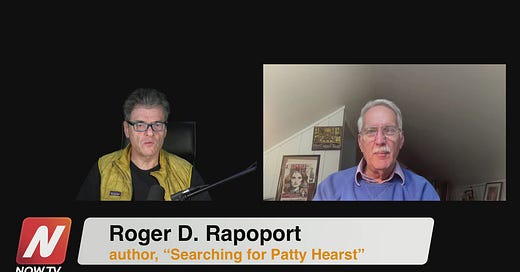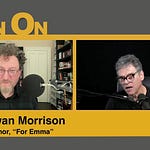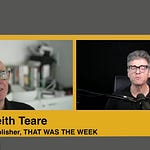You couldn’t make up the kidnapping of Patty Hearst by the Symbionese Liberation Army in February 1974. The granddaughter of William Randolph Hearst, America’s most divisive media baron, was kidnapped in Berkeley (of all places) by domestic terrorists who demand that Hearst feed the poor in exchange for the 19 year-old woman. That, in itself, was quite a story in an America still embroiled in both Vietnam and all the other aftershocks of the Sixties. But then Patty Hearst went rogue and appeared to join the SLA, participating in the heist of a San Francisco bank and changing her name to Tania, in honor of Che Guevara’s girlfriend. Such was the paranoid America of early 1974. And, according, Roger Rapoport, author of the new novel SEARCHING FOR PATTY HEARST, such is the paranoid America of early 2024. History doesn’t quite repeat itself, Rapoport explained to me. But it certainly rhymes, particularly when one compares the violent left wing cults of the early 1970’s with the violent right wing cults of the early 2020’s.
Award winning film producer, publisher, author and investigative journalist, Roger Rapoport has covered the Patty Hearst story for half a century. From his front page story in the Wall Street Journal about life on a Ford Assembly line in his junior college summer of 1967 to his fascinating coverage of the aviation industry in Angle of Attack, Roger Rapoport has received many honors for his groundbreaking reporting over the past five decades. But perhaps the highest accolade of all is a comment made years ago by one of his first editors. “Roger’s problem is that he doesn’t understand the meaning of the word no.” In 1974, Rapoport, a contributor to publications like the Atlantic, Esquire and Rolling Stone, went to work for New Times covering the kidnapping of Patty Hearst, a few blocks from his Berkeley home. His exclusive reporting focused on the life and times of Steve Weed , the fiance the Symbionese Liberation Army left behind as these revolutionaries stuffed the love of Weed’s life into a Chevy trunk and sped off into the night. Weed moved into Rapoport’s house where they wrote a big advance book together on the case. Shortly before completion the former Princeton marijuana dealer who began an affair with Patty when she was a 16 year old student at the high school where he taught, sued to block publication of the book. The following year one of Rapoport’s relatives, Los Angeles Superior Court Judge Mark Brandler (best known for the Onion Murders trial), presided over a key trial that included Patty Hearst as a defendant with two of the SLA members. After covering the San Francisco Hearst bank robbery trial in 1975 he went on, thirteen years later, to score an exclusive Oakland Tribune with Bill Harris, the man who actually kidnapped Patty Hearst and wound up fleeing cross country with her and his wife Emily Harris. While others let the story rest he interviewed Dr. Thomas Noguchi the coroner to Marilyn Monroe, Janis Joplin and Robert F. Kennedy as well as six of Hearst’s fallen Symbionese Liberation Army comrades. Year after year Rapoport continued to pursue people who refused to go public and ultimately became convinced that nonfiction accounts of the kidnapping, including Patty Hearst’s own account of her life on the run with her kidnappers, fell short. While continuing to pursue the story behind the “official” version of the case he found time to write biographies of Governors Pat and Jerry Brown, and filmmaker Michael Moore. In the midst of all his research he founded a successful publishing company, became an award winning film producer and screenwriter (Coming Up For Air), and playwright (Old Heart). During this time he wrote for STAT News and Wired, and contributed to the Los Angeles Times, San Francisco Chronicle, San Jose Mercury News, the Jewish Telegraphic Agency and the Miami Herald. “I wrote this novel,” says Rapoport, ‘because I believed the American public deserved nothing but the truth. Very sorry about the delay. This book took a lot longer that I expected. Hope it was worth the wait.”
Named as one of the "100 most connected men" by GQ magazine, Andrew Keen is amongst the world's best known broadcasters and commentators. In addition to presenting KEEN ON, he is the host of the long-running How To Fix Democracy show. He is also the author of four prescient books about digital technology: CULT OF THE AMATEUR, DIGITAL VERTIGO, THE INTERNET IS NOT THE ANSWER and HOW TO FIX THE FUTURE. Andrew lives in San Francisco, is married to Cassandra Knight, Google's VP of Litigation & Discovery, and has two grown children.













Share this post